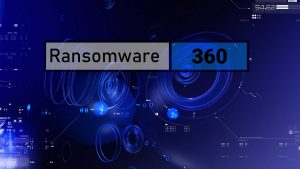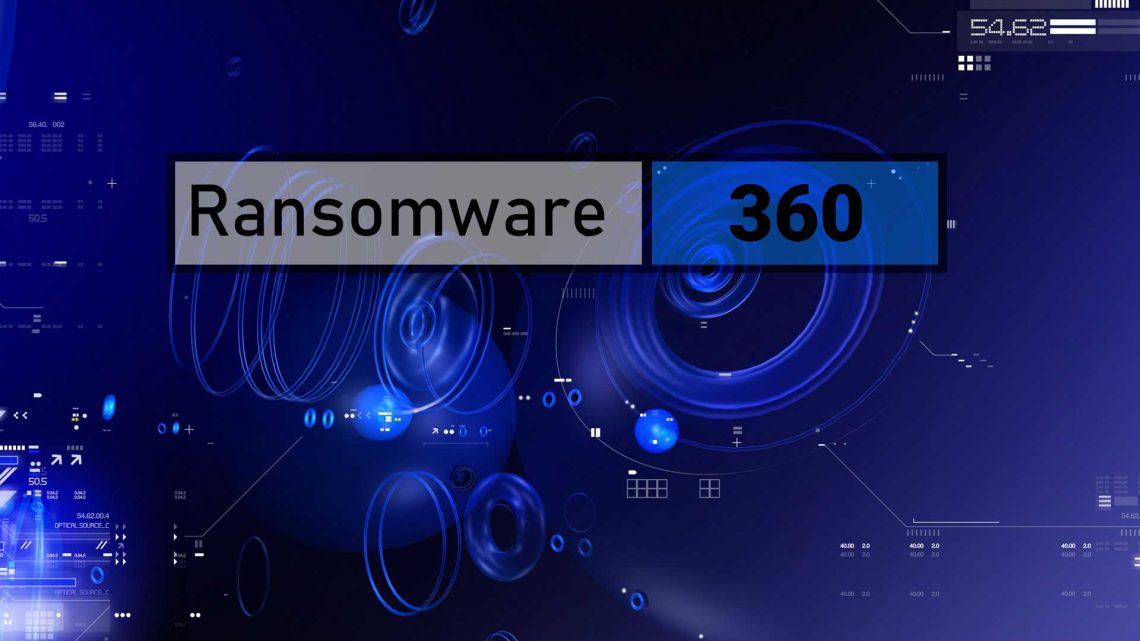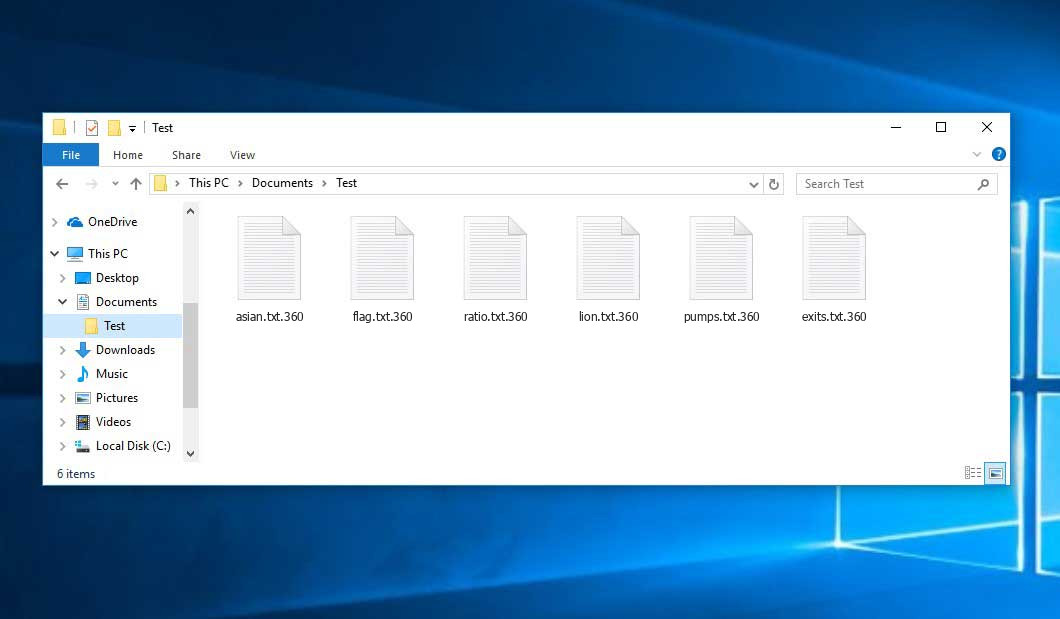The 360 virus belongs with the ransomware type of malicious agent. Malware of this type encrypts all user’s data on the PC (photos, documents, excel tables, music, videos, etc) and adds its extra extension to every file, creating the !_INFO.txt files in every directory which contains the encrypted files.
What is known about the 360virus?
☝️ A scientifically correct denomination for the 360 would be “a ransomware-type infection”.
360 adds its extra .360 extension to the title of each encoded file. For instance, an image entitled “photo.jpg” will be changed to “photo.jpg.360”. In the same manner, the Excel file with the name “table.xlsx” will be renamed to “table.xlsx.360”, and so on.
In every folder containing the encoded files, a !_INFO.txt text document will appear. It is a ransom money note. Therein you can find information about the ways of paying the ransom and some other information. The ransom note most probably contains a description of how to purchase the decryption tool from the tamperers. That is basically the scheme of the malefaction.
360 outline:
| Name | 360 Virus |
| Extension | .360 |
| Ransomware note | !_INFO.txt |
| Detection | TrojanSpy:Win32/Chaori.A, Ransom.Agent.NR, Trojan:Win32/Farfli.AC!MTB |
| Symptoms | Your files (photos, videos, documents) get a .360 extension and you can’t open them. |
| Fix Tool | See If Your System Has Been Affected by 360 virus |
In the image below, you can see what a directory with files encrypted by the 360 looks like. Each filename has the “.360” extension appended to it.
How did my computer get infected with 360 ransomware?
There are plenty of possible ways of ransomware injection.
There are currently three most exploited methods for malefactors to have the 360 virus acting in your digital environment. These are email spam, Trojan infiltration, and peer-to-peer networks.
If you access your mailbox and see emails that look just like notifications from utility services companies, postal agencies like FedEx, web-access providers, and whatnot, but whose mailer is unknown to you, be wary of opening those emails. They are very likely to have a viral file attached to them. So it is even riskier to download any attachments that come with letters like these.
Another thing the hackers might try is a Trojan virus scheme1. A Trojan is a program that gets into your machine pretending to be something different. For instance, you download an installer of some program you want or an update for some service. But what is unpacked reveals itself a harmful agent that compromises your data. Since the installation wizard can have any name and any icon, you’d better be sure that you can trust the resource of the files you’re downloading. The optimal way is to use the software developers’ official websites.
As for the peer-to-peer networks like torrent trackers or eMule, the danger is that they are even more trust-based than the rest of the Internet. You can never guess what you download until you get it. Our suggestion is that you use trustworthy websites. Also, it is a good idea to scan the directory containing the downloaded items with the anti-malware utility as soon as the downloading is complete.
How to remove the 360 virus?
It is important to note that besides encrypting your files, the 360 virus will most likely install the Azorult Spyware on your computer to get access to credentials to various accounts (including cryptocurrency wallets). That program can extract your logins and passwords from your browser’s auto-filling cardfile.
Often racketeers would decode some of your files so you know that they indeed have the decryption program. As 360 virus is a relatively new ransomware, anti-malware developers have not yet found a method to reverse its work. However, the decoding instruments are constantly upgraded, so the effective countermeasure may soon be available.
Of course, if the tamperers do the job of encoding victim’s critical data, the hopeless person will probably comply with their demands. Nevertheless, paying a ransom does not necessarily mean that you’re getting your data back. It is still risky. After getting the ransom, the racketeers may deliver a wrong decryption key to the injured party. There were reports of malefactors just disappearing after getting the money without even writing back.
The optimal safety measure against ransomware is to have a system restore point or the copies of your critical files in the cloud drive or at least on an external drive. Obviously, that might be not enough. The most crucial thing could be that one you were working upon when it all went down. Nevertheless, it is something. It is also advisable to scan your PC for viruses with the antivirus program after the system restoration.
360 is not the only ransomware of its kind, since there are other specimens of ransomware out there that act in the same manner. For instance, Eucy, Ccps, Rtgf, and some others. The two basic differences between them and the 360 are the ransom amount and the encoding method. The rest is almost identical: files become inaccessible, their extensions altered, ransom notes emerge in each folder containing encrypted files.
Some fortunate victims were able to decrypt the arrested files with the aid of the free tools provided by anti-malware specialists. Sometimes the hackers accidentally send the decryption code to the wronged in the ransom note. Such an extraordinary fail allows the victim to restore the files. But naturally, one should never rely on such a chance. Make no mistake, ransomware is a bandits’ instrument to pull the money out of their victims.
How do I avoid ransomware infection?
360 ransomware doesn’t have a superpower, so as any similar malware.
You can defend your computer from ransomware infiltration within three easy steps:
- Never open any emails from unknown mailboxes with strange addresses, or with content that has likely no connection to something you are waiting for (can you win in a money prize draw without participating in it?). In case the email subject is more or less something you are waiting for, scrutinize all elements of the questionable email carefully. A hoax letter will always contain a mistake.
- Never use cracked or unknown software. Trojan viruses are often spreaded as an element of cracked software, possibly under the guise of “patch” to prevent the license check. Understandably, potentially dangerous programs are very hard to distinguish from trustworthy ones, because trojans sometimes have the functionality you need. Try searching for information about this software product on the anti-malware message boards, but the optimal solution is not to use such software.
- And finally, to be sure about the safety of the objects you downloaded, use GridinSoft Anti-Malware. This software will be a perfect shield for your PC.
Reasons why I would recommend GridinSoft2
There is no better way to recognize, remove and prevent ransomware than to use an anti-malware software from GridinSoft3.
Download Removal Tool.
You can download GridinSoft Anti-Malware by clicking the button below:
Run the setup file.
When setup file has finished downloading, double-click on the setup-antimalware-fix.exe file to install GridinSoft Anti-Malware on your PC.

An User Account Control asking you about to allow GridinSoft Anti-Malware to make changes to your device. So, you should click “Yes” to continue with the installation.

Press “Install” button.

Once installed, Anti-Malware will automatically run.

Wait for the Anti-Malware scan to complete.
GridinSoft Anti-Malware will automatically start scanning your PC for 360 infections and other malicious programs. This process can take a 20-30 minutes, so I suggest you periodically check on the status of the scan process.

Click on “Clean Now”.
When the scan has finished, you will see the list of infections that GridinSoft Anti-Malware has detected. To remove them click on the “Clean Now” button in right corner.

Frequently Asked Questions
🤔 How can I open “.360” files?Are the “.360” files accessible?
Unfortunately, no. You need to decipher the “.360” files first. Then you will be able to open them.
🤔 The encrypted files are very important to me. How can I decrypt them quickly?
It’s good if you have fаr-sightedly saved copies of these important files elsewhere. In case you haven’t, there is still a chance that you do have a Restore Point from some time ago to roll back the whole system to the moment when it had no virus yet, but already had your files. The rest of the methods require patience.
🤔 If GridinSoft deletes the 360 malware, will it also delete my files that were encrypted?
Absolutely not! Your encrypted files are no threat to your PC.
GridinSoft Anti-Malware will delete active infections from your computer. The ransomware that has infected your PC is most likely still functional and running scans every so often to encrypt any new files you might create on your PC after the infection. As it has been said above, the 360 virus does not come alone. It installs backdoors and keyloggers that can take your account passwords by trespassing and provide hackers with easy access to your system in the future.
🤔 What to do if the 360 malware has blocked my computer and I can’t get the activation code.
In such an unfortunate situation, you need to prepare a flash memory drive with a pre-installed Trojan Killer. Use Safe Mode to perform the procedure. You see, the ransomware starts automatically as the system launches and encodes any new files created or imported into your system. To stop this process – use Safe Mode, which allows only the vital applications to run upon system boot. Consider reading our manual on booting Windows in Safe Mode.
🤔 What can I do right now?
Many of the encoded files might still be at your disposal
- If you sent or received your critical files through email, you could still download them from your online mail server.
- You may have shared images or videos with your friends or relatives. Just ask them to give those images back to you.
- If you have initially got any of your files from the Internet, you can try downloading them again.
- Your messengers, social networks pages, and cloud drives might have all those files too.
- Maybe you still have the needed files on your old computer, a laptop, mobile, flash memory, etc.
USEFUL TIP: You can employ file recovery utilities4 to retrieve your lost information since ransomware encrypts the copies of your files, removing the original ones. In the video below, you can learn how to use PhotoRec for such a restoration, but remember: you can do it only after you remove the virus with an antivirus program.
Also, you can contact the following official fraud and scam sites to report this attack:
- In the United States: On Guard Online;
- In Canada: Canadian Anti-Fraud Centre;
- In the United Kingdom: Action Fraud;
- In Australia: SCAMwatch;
- In New Zealand: Consumer Affairs Scams;
- In France: Agence nationale de la sécurité des systèmes d’information;
- In Germany: Bundesamt für Sicherheit in der Informationstechnik;
- In Ireland: An Garda Síochána;
To report the attack, you can contact local executive boards. For instance, if you live in USA, you can have a talk with FBI Local field office, IC3 or Secret Service.
I need your help to share this article.
It is your turn to help other people. I have written this article to help people like you. You can use the buttons below to share this on your favorite social media Facebook, Twitter, or Reddit.
Brendan SmithHow to Remove 360 Ransomware & Recover PC

Name: 360 Virus
Description: 360 Virus is a ransomware-type infections. This virus encrypts important personal files (video, photos, documents). The encrypted files can be tracked by a specific .360 extension. So, you can't use them at all.
Operating System: Windows
Application Category: Virus
User Review
( votes)References
- You can read more on Trojans, their use and types in the Trojan-dedicated section of GridinSoft official website.
- GridinSoft Anti-Malware Review from HowToFix site: https://howtofix.guide/gridinsoft-anti-malware/
- More information about GridinSoft products: https://gridinsoft.com/comparison
- Here are Top 10 Data Recovery Software Of 2023.



